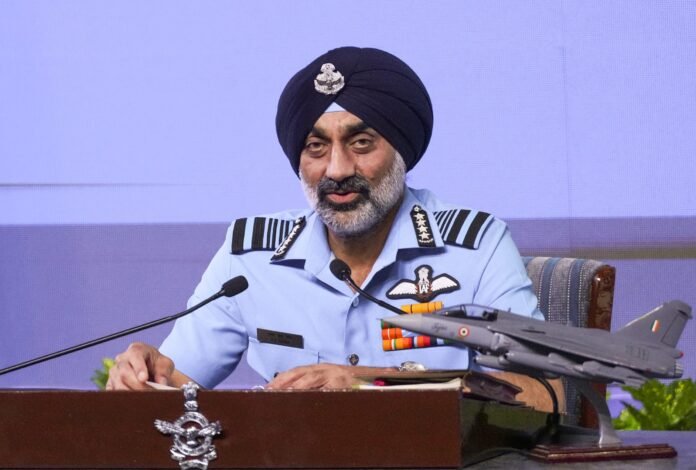New Delhi: Rejecting Pakistan’s claims about Operation Sindoor, Chief of Air Staff Air Chief Marshal Amar Preet Singh, while addressing a press conference in the national capital on October 3 to mark the occasion of the 93rd Air Force Day, provided a detailed account of the damage inflicted on Islamabad during the May strikes. He said that 4 to 5 Pakistani fighter jets, most likely F-16s, were destroyed during India’s air strikes under Operation Sindoor. Singh said the operation caused “substantial damage” to Pakistani airbases, radars, command centres, and runways.
“We struck a large number of their airfield and we struck a large number of installations,” AP Singh said in response to a question. He went on to outline the extensive losses suffered by Pakistan, saying the Indian strikes hit “radars at least four places, command and control centres at two places, runways of course damaged at two places, then three of their hangars in three different stations have been damaged.”
He said, “Along with that, one SAM system has been destroyed…We have clear evidence of one long-range strike, which I talked about more than 300 km, which happened to be either an AEW&C or a SIGINT aircraft. Along with that, five high-tech fighters between F-16 and JF-17 class—this is what our system tells us.”
Mocking Islamabad for claiming it had downed Indian jets, calling them “manohar kahaniyan (fascinating tales),” Air Chief Marshal AP Singh added, “If they think they downed our 15 jets, I hope they are convinced about it and they will cater for 15 less aircraft in my inventory when they come to fight again.”
Air Chief Marshal AP Singh said that India launched Operation Sindoor with a clear aim and the termination of the conflict in quick time after the objective was met is a lesson for the world to learn from. Delving into various aspects of Operation Sindoor, he said it was a reflection of tri-services synergy. He also said the his force has drawn up a Roadmap 2047 to enhance its combat capabilities.
India launched Operation Sindoor on May 7 in response to the April 22 Pahalgam attack, targeting terror infrastructure in territories controlled by Pakistan. The strikes triggered four days of intense clashes that ended with an understanding on stopping the military actions on May 10.
IAF Chief AP Singh said that ‘Operation Sindoor’ was a testament of IAF’s combat capability and operational synergy.
The IAF chief responding to a question, said all three services have started working on the ‘Sudarshan Chakra’ air defence system. Announced by Prime Minister Narendra Modi on August 15, the project will develop an indigenous air defence system to protect India’s vital military and civilian installations and to deliver a decisive response to any enemy threat. Asked if the IAF was looking at procuring more S-400 air defence missiles, the Air Chief Marshal didn’t give a direct reply but said the platform proved to be a good one.
Providing updates on the IAF’s modernisation plans, IAF Chief AP Singh said the indigenously developed Advanced Medium Combat Aircraft (AMCA) is expected to take its first flight by 2028 and be inducted into service by 2035, calling the timeline “achievable, or perhaps even faster if pursued with full commitment.”
Singh noted that Rafale remains a strong contender given its proven suitability during the earlier MMRCA contract, but clarified that all options – including Russia’s Su-57 – would be weighed strictly on merit, with preference for technology transfer and manufacturing in India.
IAF Chief Singh asserted that India retains the capability to strike such hideouts with precision. “If intelligence is available, we can go deep inside and destroy them. Our options remain open,” he said while commenting on reports of terrorist groups shifting their bases deeper into Pakistan’s Khyber Pakhtunkhwa.






